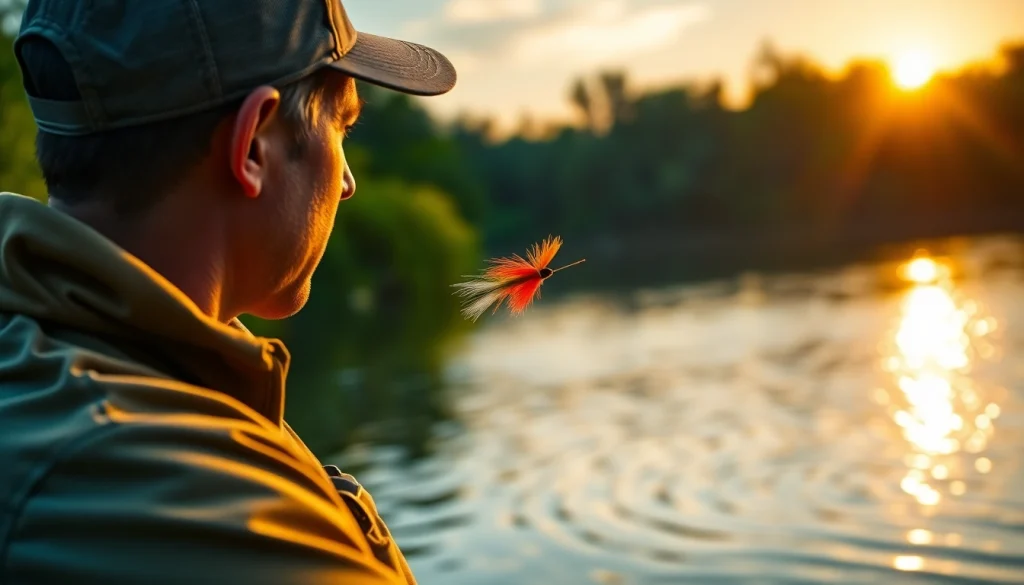Mastering Fly Fishing for Bass: Techniques, Gear, and Essential Tips

Understanding the Basics of Fly Fishing for Bass
Fly fishing for bass is not only a rewarding angling pursuit, but it also combines skill, patience, and an understanding of the aquatic environment. Whether you’re a seasoned angler or a novice, understanding the fundamentals of this technique can dramatically enhance your experience and success on the water. First and foremost, what exactly is fly fishing for bass? It differs from traditional bait fishing by using artificial flies to lure the fish. This method offers a unique challenge and satisfaction as anglers navigate casting techniques, understanding bass behavior, and perfecting their gear. If you’re looking to explore the nuances of this fishing style, Fly fishing for bass provides an excellent starting point.
What is Fly Fishing for Bass?
Fly fishing for bass targets two primary species: the Largemouth Bass and the Smallmouth Bass. These species inhabit a wide range of freshwater environments, from lakes and rivers to ponds and reservoirs. The technique relies on a specialized method of fishing where anglers use a fly rod, reel, and a selection of artificial flies—lightweight lures that mimic various aquatic organisms.
The lure is cast using a technique that varies from standard fishing, making it an engaging experience that often requires more skill. The fly rod is longer and more flexible than conventional fishing rods, designed specifically for casting lighter lures. This allows for a more delicate presentation, which is crucial when trying to entice bass, especially in clear waters with educated fish.
Essential Gear for Fly Fishing for Bass
Having the right gear is critical for success in fly fishing for bass. To fully experience the art and technique of this form of fishing, consider the following essential items:
- Fly Rod: For bass, a 6 to 8-weight rod is generally recommended, providing enough strength to handle larger fish while maintaining sensitivity.
- Fly Reel: Choose a large arbor reel with an adjustable drag. This allows you to manage the line efficiently, especially when you’re dealing with spirited bass.
- Fly Line: A floating or sinking line, depending on your fishing style and the conditions in which you’re fishing. Floating lines are better for surface flies, while sinking lines work well for deeper presentations.
- Leaders and Tippets: A durable leader line is essential for structural protection, ranging from 10-20 lb test for bass fishing. Tippets can be adjusted depending on the type of flies you are using.
- Flies: Familiarize yourself with a variety of fly patterns that mimic baitfish, crayfish, and other prey species that bass commonly chase. Knowing when to use which flies can make a significant difference.
Choosing the Right Location for Bass
Location is an integral aspect of fishing success. When targeting bass with flies, some of the best locations to consider include:
- Lakes and Ponds: Look for areas with submerged vegetation, structures like rocks, and drop-offs. These features provide bass with ambush points for feeding.
- Rivers and Streams: Focus on eddies, riffles, and backwater areas where bass may take refuge. Moving water can present unique challenges, often requiring quick adjustments to your techniques.
- Marshes and Estuaries: These environments provide rich habitats for bass feeding on various insects and aquatic organisms.
Key Techniques for Successful Fly Fishing for Bass
Effective Casting Techniques
Mastering casting techniques is essential for maximizing success on your fishing trip. The two-handed cast and roll cast are particularly effective for fly fishing for bass:
Two-Handed Cast: This technique allows for greater control and distance, particularly in windy conditions. Alternating your top hand back while pushing forward with your lower hand will launch the line more effectively.
Roll Cast: Ideal for confined spaces where overhead casting is impractical, the roll cast helps place your fly in the water without a backcast. This technique is especially useful in dense vegetation.
Understanding Bass Behavior
Understanding the behavior of bass at different times of the day and seasons can vastly improve your fishing results. Bass are generally more active at dawn and dusk, which is when they actively feed. Additionally, during the hotter months, bass may move to deeper water to escape rising temperatures. As a skilled angler, consider the time of day, season, and even the current weather conditions when planning your strategy.
Reading Water and Identifying Structures
Being able to read water and locate structures significantly impacts your fishing success. Bass tend to congregate near structures like submerged logs, rocks, or aquatic vegetation, using them as cover to ambush prey. Look for areas with:
- Current Breaks: When fishing in rivers, look for slower waters adjacent to faster currents.
- Drop-offs: Locations where the depth increases can be prime feeding areas for bass looking for ambush points.
- Shade: Areas where the sun is blocked can provide sanctuary for bass.
Choosing the Right Flies for Bass
Popular Fly Patterns for Fly Fishing for Bass
Selecting the right fly patterns is fundamental for enticing bass. Some popular choices include:
- Poppers: These imitate baitfish and elicit aggressive strikes, especially in warmer months.
- Clouser Minnows: Excellent for presenting an underwater profile that targets bass looking for smaller fish.
- Crayfish Flies: Providing a natural offering that can entice bass during their spring feeding frenzy.
Seasonal Fly Selection Strategies
Each season dictates different bass feeding patterns influenced by water temperature and environmental changes. During spring, for example, bass may be more aggressive and responsive to swimming and surface presentations, while in summer, they may prefer deeper, cooler parts of the water column. An adaptable approach to fly selection throughout the seasons can significantly enhance your catch rate.
Matching Flies to the Environment
Understanding the local environment is crucial when selecting the right flies. Observe the color of the water, the types of forage present, and the fishing conditions. Clearer waters often require more subtly colored flies, while murkier waters might call for darker, more pronounced colors. Explore various sizes and styles to find what resonates best with the bass during your fishing outing.
Advanced Strategies for Fly Fishing for Bass
Techniques for Catching Largemouth and Smallmouth Bass
The techniques used for catching Largemouth and Smallmouth bass can vary. Largemouth bass often reside in shallow, weedy waters, making poppers and surface flies very effective. In contrast, Smallmouth bass prefer faster-moving water and can often be caught using deeper-sinking flies or streamers, particularly in the currents.
Adjusting Tactics Based on Weather Conditions
Weather conditions can have a profound impact on bass behavior. Overcast days may prompt them to move closer to the surface, making it an excellent opportunity for top-water flies. Conversely, during periods of high sun, bass may retreat to deeper waters. Continuously observing the environmental changes and adjusting your tactics will ensure higher productivity.
Tips for Targeting Spawning Bass
Spawning season is a prime time to target bass, as they become aggressive in defending their nests. When targeting spawning bass, it’s vital to approach with caution. Use subtle presentations and position your casts near their spawning beds without spooking them. Here, it’s beneficial to use flies that represent food sources or are less conspicuous to avoid alarming the fish.
Resources and Communities for Fly Fishing for Bass Enthusiasts
Online Forums and Groups
The fly fishing community thrives online, providing ample opportunities for anglers to engage, share tips, and gather local knowledge. Websites and social media groups can serve as excellent resources for connecting with fellow anglers, sharing experiences, and exchanging information about local fly patterns and techniques.
Recommended Books and Tutorials
Investing time into educational resources can enhance your understanding and skill set. Numerous books and online tutorials offer insights into advanced techniques, environmental considerations, and effective fly patterns. Seek out recent publications and videos from reputable sources to stay updated on the latest trends in bass fishing.
Local Fly Fishing Clubs and Events
Joining local fly fishing clubs can provide hands-on experiences, enhanced networking, and learning opportunities. Many clubs organize fishing events and workshops, giving you the chance to learn from experienced anglers and share your own insights with others. Events can also be a wonderful way to discover new fishing locations and techniques specific to your area.




